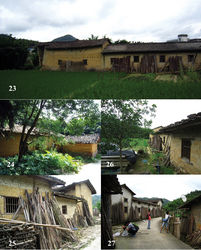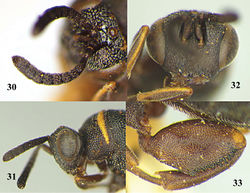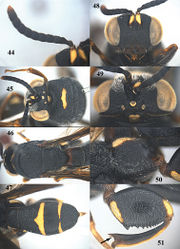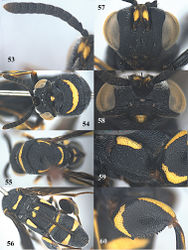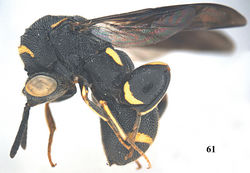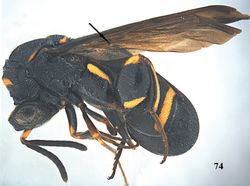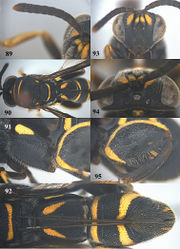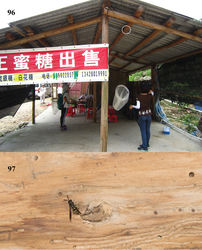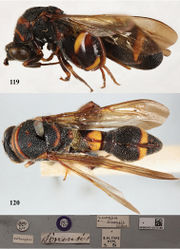| 1 | | | Hind femur with 3–4 long and slender teeth (apart from small apical teeth; Figs 87, 95, 105, 118, 119); basal tooth of hind femur smaller than following three teeth (Figs 87, 95, 105, 118, 119) | | | 2 |
| |
|
| – | | | Hind femur with many small to medium-sized teeth (Figs 4, 13, 22, 33, 42, 51, 60, 70, 83); basal tooth of hind femur larger than following teeth or about as large (Figs 4, 13, 22, 33, 42, 51, 60, 70, 83) | | | 6 |
| |
|
| 2 | | | Ovipositor sheath medium-sized, up to middle of T5 (Figs 114, 120); frons black (Fig. 115); T1 of ♂ truncate posteriorly; metasoma of ♂ distinctly constricted subbasally | | | 3 |
| |
|
| – | | | Ovipositor sheath long, at least up to T1 (Figs 85, 92, 102); frons or frontovertex usually with yellow patch laterally (Figs 86, 93, 103); T1 of ♂ concave posteriorly; metasoma of ♂ slightly constricted subbasally | | | 4 |
| |
|
| 3 | | | Malar space 0.17–0.19 times height of eye (about as long as width of F2); hind femur finely and sparsely punctate and with large smooth interspaces (Fig. 119); T1 of ♀ without ovipositorial furrow, but with median carina (Fig. 120); premarginal carina of pronotum usually distinct; anterior half of T5 black (Fig. 120) | | | Leucospis sinensis Walker |
| |
|
| – | | | Malar space 0.22–0.30 times height of eye (Fig. 115; at least 1.2 times as long as width of F2); hind femur finely and densely punctate and with small smooth interspaces (Fig. 118); T1 of ♀ without ovipositorial furrow or carina medially (Fig. 114); premarginal carina of pronotum indistinct and replaced by a raised but blunt rib (Fig. 112); anterior half of T5 of Chinese specimens reddish brown (Fig. 114) | | | Leucospis petiolata Fabricius |
| |
|
| 4 | | | Dorsellum rounded posteriorly (Fig. 90); anterior ridge separating double ovipositorial furrow broad and coarsely punctate (Figs 90, 92); hind coxa partly impunctate medio-posteriorly (Fig. 91) | | | Leucospis histrio Maindron |
| |
|
| – | | | Dorsellum bidentate or concave posteriorly (Fig. 102); at most with a narrow and smooth anterior ridge separating double ovipositorial furrow (Fig. 102); hind coxa usually without impunctate area (Fig. 101) | | | 5 |
| |
|
| 5 | | | F2–F4 of ♀ broader than long (Fig. 99; also in ♂); clypeus at most moderately protruding ventrally (Fig. 103); ovipositor sheath at least reaching anterior margin of T1 (Fig. 102) | | | Leucospis intermedia Illiger |
| |
|
| – | | | F2–F4 of ♀ distinctly longer than broad (also in ♂); clypeus conspicuously protruding ventrally (Fig. 86); ovipositor sheath usually not reaching anterior margin of T1 (Figs 84, 85) | | | Leucospis gigas Fabricius |
| |
|
| 6 | | | T1 of ♀ without ovipositorial furrow medially (Figs 2, 107); ovipositor sheath up to basal third of T5 (Figs 2, 107); hind tibia truncate apically, without apical spine (Fig. 4); body largely pale orange or reddish brown (Figs 1, 2, 106, 107) | | | 7 |
| |
|
| – | | | T1 of ♀ with ovipositorial furrow medially (Figs 9, 29, 38, 56, 85); ovipositor sheath at least extending up to T1 (Figs 9, 29, 38, 56, 85); body largely black with yellow or orange pattern (Figs 5, 14, 28, 34, 43, 52, 61, 74); hind tibia protruding ventro-apically, with distinct apical spine (Figs 33, 42, 51, 61, 79, 83) | | | 8 |
| |
|
| 7 | | | Hind leg entirely orange without any pattern (Figs 1, 4); hind femur shiny and sparsely pubescent (Fig. 4); mesoscutum bicoloured (orange with black pattern; Fig. 2); ovipositorial furrow up to anterior margin of T1 (Fig. 2); dorsellum distinctly bifurcate dorso-posteriorly (Fig. 2) | | | Leucospis aurantiaca Shestakov |
| |
|
| – | | | Hind leg reddish brown to blackish brown, with yellow pattern (Fig. 106); hind femur mostly dull and densely pubescent (Fig. 106); mesoscutum tricoloured, black with yellow and reddish brown patches (Fig. 107); ovipositorial furrow up to middle of T5 (Fig. 107); dorsellum posteriorly with evenly curved carinae, weakly protruding dorso-posteriorly (Fig. 107) | | | Leucospis bakeri Crawford |
| |
|
| 8 | | | Discal carina of pronotum absent or indistinct and not angularly raised medially (Figs 5, 7, 14, 16, 28, 31); premarginal and marginal carinae usually less conspicuous (Figs 5, 7, 31) | | | 9 |
| |
|
| – | | | Discal carina of pronotum distinct and subangularly raised medially (Figs 34, 36, 43, 46, 61, 77); premarginal and marginal carinae conspicuously developed (Figs 34, 43, 74) | | | 10 |
| |
|
| 9 | | | T1 of ♀ with very shiny broad and convex ridge between double ovipositorial furrow anteriorly (Fig. 9); hind femur mainly black and with large and more or less lunate yellow patch (Figs 5, 13); scape yellow ventrally (Figs 6, 10, 11); ovipositor sheath reaching dorsellum (Figs 8, 9) | | | Leucospis japonica Walker |
| |
|
| – | | | T1 of ♀ ovipositorial furrow single, without shiny convex ridge anteriorly (Fig. 29); hind femur mainly blackish brown, with small obscure yellowish patch apico-dorsally (Figs 28, 33); scape blackish brown ventrally (Fig. 32); ovipositor sheath up to anterior margin of T1 (Fig. 29) | | | Leucospis yasumatsui Habu |
| |
|
| 10 | | | T1 in lateral view steep anteriorly, almost rectangularly protruding (indicated by arrow in Figs 34, 74), distinctly above dorsal level of mesosoma and in dorsal view with deep ovipositorial furrow medio-dorsally (Figs 38, 78); area next to ovipositorial furrow with smooth interspaces between moderately coarse punctures broad (mostly about equal to diameter of puncture or somewhat broader); ovipositorial furrow distinctly impressed on T4 (Figs 38, 78); flagellomeres of ♀ (except F1) hardly narrowed basally, F2–F4 of ♀ distinct longer than broad (Figs 35, 75); hind femur with an elongate triangular yellow patch ventrally (Figs 42, 51, 74, 83) | | | 11 |
| |
|
| – | | | T1 in lateral view gradually lowered anteriorly (indicated by arrow in Fig. 52), near dorsal level of mesosoma and in dorsal view with shallower ovipositorial furrow medio-dorsally (Fig. 56); area next to ovipositorial furrow with rather narrow smooth interspaces between very coarse punctures (mostly narrower than diameter of puncture); ovipositorial furrow rather shallowly impressed on T4 (Fig. 56); flagellomeres of ♀♂ narrowed basally, F2–F5 of both sexes broader than long or as long as broad (Figs 53, 54, 62); hind femur with a lunate yellow mark subbasally (Figs 52, 60, 61, 70) | | | Leucospis femoricincta Bouček |
| |
|
| 11. | | | Concavity below apical spine of hind tibia with slender spines and long setae (indicated by arrow in Fig. 83); mesoscutum with a pair of obscure yellow spots submedially and a pair of yellow stripes laterally (Figs 76, 77); teeth of hind femur forming a rather irregular row (Figs 74, 83); yellow band of T5 of ♀ in lateral view distinctly broader than apical black band (Figs 74, 78) | | | Leucospis shaanxiensis sp. n. |
| |
|
| – | | | Concavity below apical spine of hind tibia with rather robust spines and shorter setae (indicated by arrow in Fig. 51); mesoscutum without yellow patch laterally or yellow spots submedially (Figs 37, 46); teeth of hind femur forming a regular row (Figs 42, 43, 51); yellow band of T5 of ♀ in lateral view at most about as broad as apical black band (Figs 34, 38) | | | Leucospis aequidentata sp. n. |
| |






